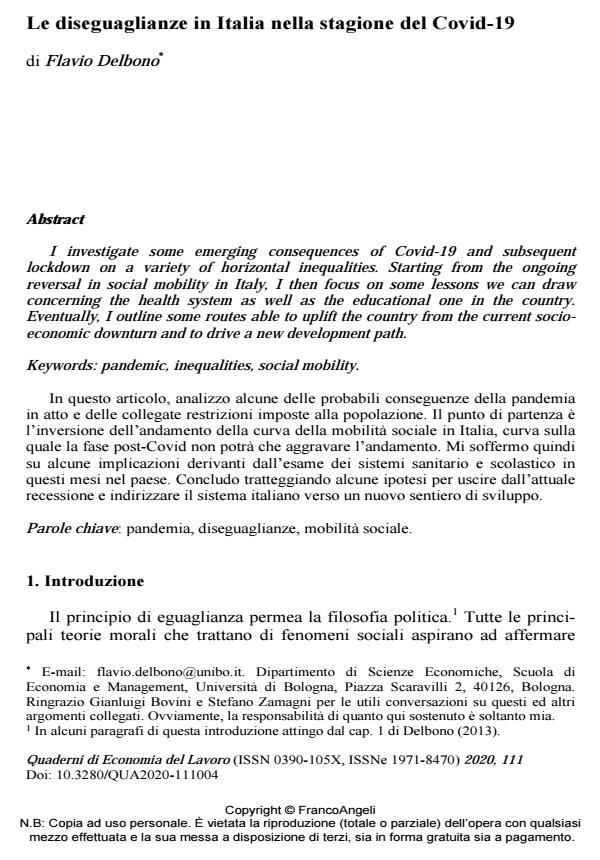Le diseguaglianze in Italia nella stagione del Covid-19
Titolo Rivista QUADERNI DI ECONOMIA DEL LAVORO
Autori/Curatori Flavio Delbono
Anno di pubblicazione 2021 Fascicolo 2020/111
Lingua Italiano Numero pagine 14 P. 73-86 Dimensione file 168 KB
DOI 10.3280/QUA2020-111004
Il DOI è il codice a barre della proprietà intellettuale: per saperne di più
clicca qui
Qui sotto puoi vedere in anteprima la prima pagina di questo articolo.
Se questo articolo ti interessa, lo puoi acquistare (e scaricare in formato pdf) seguendo le facili indicazioni per acquistare il download credit. Acquista Download Credits per scaricare questo Articolo in formato PDF

FrancoAngeli è membro della Publishers International Linking Association, Inc (PILA)associazione indipendente e non profit per facilitare (attraverso i servizi tecnologici implementati da CrossRef.org) l’accesso degli studiosi ai contenuti digitali nelle pubblicazioni professionali e scientifiche
In questo articolo, analizzo alcune delle probabili conseguenze della pandemia in atto e delle collegate restrizioni imposte alla popolazione. Il punto di partenza è l’inversione dell’andamento della curva della mobilità sociale in Italia, curva sulla quale la fase post-Covid non potrà che aggravare l’andamento. Mi soffermo quindi su alcune implicazioni derivanti dall’esame dei sistemi sanitario e scolastico in questi mesi nel paese. Concludo tratteggiando alcune ipotesi per uscire dall’attuale recessione e indirizzare il sistema italiano verso un nuovo sentiero di sviluppo.
Parole chiave:Pandemia, diseguaglianze, mobilità sociale.
- Agranov M., Eilat R. e Sonin K. (2020). A Politica Model of Trust. WP 2020-50. Becker Friedman Institute.
- Belot M., Choi S., Tripodi E., van den Broek-Altenburg E., Jamison J. e Papageorge N. (2020). Unequal Consequences of Covid-19 across Age and Income: Representative Evidence from Six Countries. Iza D. P. 13366.
- Berg A., Ostry J., Tsangarides C. e Yakhshilikov Y. (2018). Redistribution, inequality, and growth: new evidence. Journal of Economic Growth, 23: 250-305.
- Brandolini A., Gambacorta R. e Rosolia A. (2018). Inequality amid Income Stagnation: Italy over the Last Quartery of a Century. Occasional Paper 442. Bank of Italy.
- Chancel L. (2019). Ten facts about inequality in advanced economies. WID.world WP 2019/15.
- Delbono F. (2013). La piramide del potere: diseguaglianza e crisi economiche. Bologna: Editrice Compositori.
- Fondazione CENSIS (2020). I soggetti dell’Italia che c’è e il loro fronteggiamento della crisi. Roma.
- Fondazione David Hume (2015). “Diseguaglianza economica in Italia e nel mondo”. Dossier I/2015. Torino.
- Gylfason T. (2019). “Inequality Undermines Democracy and Growth”. CESifo WP 7486.
- ISTAT (2020). “Rapporto annuale – La situazione del paese”. Roma.
- Kearney M. e Levine P. (2016). “Income Inequality, Social Mobility and the Decision to Drop Out of High School”. NBER WP 20195.
- King M. (2017). La fine dell’alchimia. Milano: Il Saggiatore.
- OCSE (2012). Less Income Inequality and More Growth. Parigi.
- Ricolfi L. (2019). La società signorile di massa. Milano: La nave di Teseo.
- Scheidel W. (2019). La grande livellatrice: violenza e diseguaglianza dalla preistoria a oggi. Bologna: il Mulino.
- Sen A. (2009). The Idea of Justice. Londra: Allen Lane.
- Snower, D. (2020). “The Socio-Economics of Pandemics Policy”. CESifo WP 8314.
- Stiglitz J. (2012). The Price of Inequality. New York Norton. (trad. it.: Il prezzo della diseguaglianza. Torino: Einaudi, 2013).
- Taleb N. (2008). Il cigno nero. Milano: Il Saggiatore.
- Zamagni S. (2019). Responsabili. Come civilizzare il mercato. Bologna: il Mulino.
- Zamagni, S. (2020). La Pandemia da Covid-19: Factum e Faciendum. Mimeo.
- Zuboff S. (2019). Il capitalismo della sorveglianza: il futuro dell’umanità nell’era dei nuovi poteri. Roma: Luiss University Press.
Flavio Delbono, Le diseguaglianze in Italia nella stagione del Covid-19 in "QUADERNI DI ECONOMIA DEL LAVORO" 111/2020, pp 73-86, DOI: 10.3280/QUA2020-111004